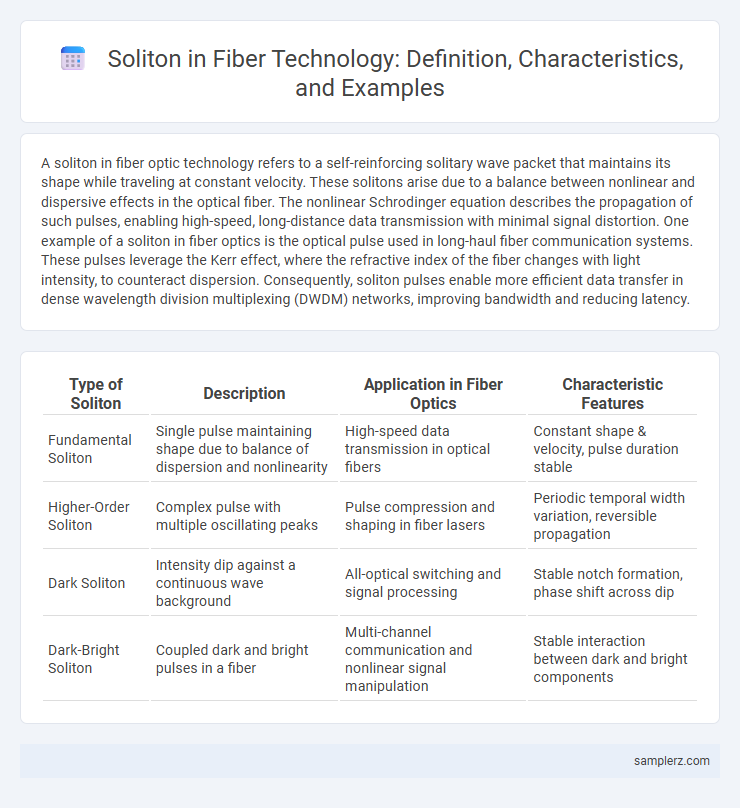A soliton in fiber optic technology refers to a self-reinforcing solitary wave packet that maintains its shape while traveling at constant velocity. These solitons arise due to a balance between nonlinear and dispersive effects in the optical fiber. The nonlinear Schrodinger equation describes the propagation of such pulses, enabling high-speed, long-distance data transmission with minimal signal distortion. One example of a soliton in fiber optics is the optical pulse used in long-haul fiber communication systems. These pulses leverage the Kerr effect, where the refractive index of the fiber changes with light intensity, to counteract dispersion. Consequently, soliton pulses enable more efficient data transfer in dense wavelength division multiplexing (DWDM) networks, improving bandwidth and reducing latency.
Table of Comparison
| Type of Soliton | Description | Application in Fiber Optics | Characteristic Features |
|---|---|---|---|
| Fundamental Soliton | Single pulse maintaining shape due to balance of dispersion and nonlinearity | High-speed data transmission in optical fibers | Constant shape & velocity, pulse duration stable |
| Higher-Order Soliton | Complex pulse with multiple oscillating peaks | Pulse compression and shaping in fiber lasers | Periodic temporal width variation, reversible propagation |
| Dark Soliton | Intensity dip against a continuous wave background | All-optical switching and signal processing | Stable notch formation, phase shift across dip |
| Dark-Bright Soliton | Coupled dark and bright pulses in a fiber | Multi-channel communication and nonlinear signal manipulation | Stable interaction between dark and bright components |
Understanding Solitons: Definition and Characteristics
Solitons in fiber optics are stable, self-reinforcing solitary waves that maintain their shape and speed over long distances due to a balance between dispersion and nonlinearity in the fiber. These pulses exhibit unique characteristics such as robustness against wave dispersion, making them essential for high-speed, long-distance optical communication. Understanding solitons involves analyzing parameters like pulse width, amplitude, and the nonlinear Schrodinger equation governing their propagation in fiber.
Historical Development of Fiber Optic Solitons
The historical development of fiber optic solitons began with the discovery of optical pulses maintaining their shape over long distances, first demonstrated by Linn F. Mollenauer in 1980 using silica fibers. These solitons arise from the balance between fiber dispersion and the nonlinear Kerr effect, enabling stable data transmission with minimal distortion. The implementation of fiber optic solitons revolutionized long-haul communications by significantly reducing signal degradation and enhancing bandwidth efficiency.
Basic Principles of Solitons in Optical Fibers
Solitons in optical fibers are stable, self-reinforcing light pulses that maintain their shape during propagation due to a balance between nonlinear Kerr effect and chromatic dispersion. The nonlinear refractive index induces a phase modulation that counteracts pulse broadening caused by dispersion, enabling long-distance, distortion-free signal transmission. This phenomenon is crucial for high-speed fiber-optic communication systems, where solitons enable improved data integrity and transmission efficiency.
Types of Solitons Observed in Fiber Optics
In fiber optics, the main types of solitons observed include fundamental solitons, which maintain their shape due to a balance between chromatic dispersion and Kerr nonlinearity, and higher-order solitons that exhibit periodic shape changes while preserving energy. Dark solitons, characterized by localized intensity dips on a continuous wave background, arise from normal dispersion regimes. Dispersion-managed solitons benefit from engineered fiber segments with alternating dispersion to enhance transmission stability and reduce pulse broadening in long-haul optical communication systems.
Example: Fundamental Soliton Propagation in Single-Mode Fiber
Fundamental soliton propagation in single-mode fiber exemplifies stable pulse transmission maintained by a precise balance between chromatic dispersion and the fiber's nonlinear Kerr effect. These solitons preserve their shape and speed over long distances without dispersion-induced broadening, making them ideal for high-capacity optical communication systems. Experimental studies demonstrate how fundamental solitons enable error-free data transfer in ultra-long-haul fiber optic networks.
Dispersion Management and Soliton Transmission
Solitons in fiber optics exemplify stable pulse propagation enabled by precise Dispersion Management, which balances anomalous dispersion and nonlinear Kerr effects to maintain pulse shape over long distances. Effective soliton transmission leverages dispersion-managed fibers where periodic variation of dispersion parameters compensates for pulse broadening and enhances signal integrity. This technique is crucial for ultra-fast communication systems, reducing bit error rates and supporting high-capacity data links in modern telecommunication networks.
Applications of Soliton Pulses in Fiber-Optic Communication
Soliton pulses in fiber-optic communication enable ultra-long-distance data transmission with minimal signal distortion due to their ability to maintain shape and speed over vast distances. These stable, nonlinear wave packets counteract dispersion effects, allowing for higher bandwidth and improved signal integrity in high-capacity fiber networks. Major applications include undersea communication cables, high-speed internet infrastructure, and advanced telecommunication systems requiring reliable, high-speed data transfer.
Recent Advances in Soliton-Based Optical Networks
Recent advances in soliton-based optical networks have demonstrated enhanced data transmission stability through the use of dispersion-managed fibers and advanced modulation formats. Innovations in soliton interaction control and real-time monitoring techniques have significantly increased network capacity and minimized signal distortion over long distances. Experimental implementations incorporating machine learning algorithms optimize soliton propagation, leading to improved performance in next-generation high-speed optical communication systems.
Challenges in Implementing Soliton Systems
Implementing soliton systems in fiber optics faces challenges such as managing dispersion and nonlinearity to maintain pulse shape over long distances. Precise control of initial pulse parameters and fiber properties is essential to prevent soliton distortion caused by fiber losses and higher-order effects. Advanced amplification techniques like erbium-doped fiber amplifiers (EDFAs) are required to counteract signal attenuation without disrupting soliton dynamics.
Future Trends in Fiber Soliton Technologies
Fiber solitons, stable optical pulses maintaining their shape over long distances, are pivotal in advancing high-capacity telecommunication networks. Emerging trends include leveraging nonlinear photonic crystal fibers and integrating soliton-based systems with machine learning for adaptive signal optimization. Quantum soliton communications and ultra-fast data transmission exploiting soliton dynamics promise breakthroughs in future optical network performance.

example of soliton in fiber Infographic
 samplerz.com
samplerz.com